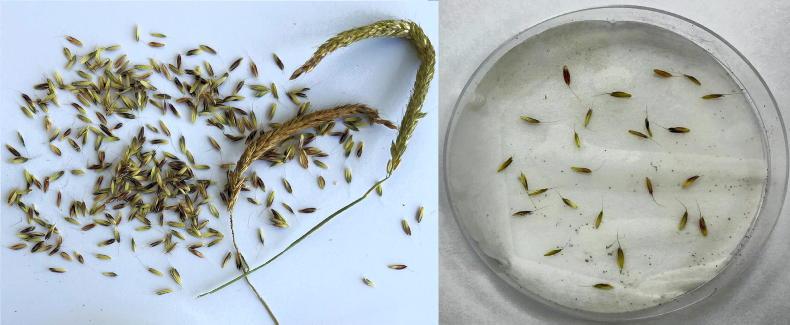Farmers across the country have been submitting weed seeds for testing that they suspect to be resistant to herbicides.
Resistance tests on suspected populations of any grass or broad-leaved weeds are encouraged. This service from Teagasc Oak Park is for free for a limited time, as part of the DAFM-funded EVOLVE research project.
Tests conducted to date on resistance-suspect samples (Figure 1):
Show >60% of blackgrass and >80% of Italian ryegrass were ACCase and/or ALS-resistant.Confirmed the first case of Italian ryegrass resistant to glyphosate, ACCase and ALS herbicides.
Show 34% of wild oats were ACCase-resistant.Resistance to ALS herbicides was confirmed in some meadow grasses.
Resistance to ALS (eg. Ally Max, Cameo Max, Pacifica, Broadway) herbicides was confirmed in poppy, chickweed, common field-speedwell and corn marigold.The number of weeds that have developed resistance, and the herbicide modes of action they’re resistant to, continue to rise, posing a serious threat to future crop production.
Knowing the resistance status of different weeds and populations is essential to tackling this challenge and resistance testing is one key step.
To obtain comprehensive results from testing, it is critical to collect and submit quality samples of your target weed(s).
Please follow these steps:
For grass weeds, collect ripe seeds that easily fall-off the seed head when brushed, stroked, or shaken vigorously into a paper envelope. For broadleaved weeds, collect ripe seed heads or capsules or seeds directly into a paper envelope. Ensure you collect an adequate quantity of seeds. See the picture (left).Complete the herbicide resistance testing form (scan QR code on opposite page).Send the paper bags of dry seeds, along with the completed form to: Vijaya Bhaskar, Teagasc Crops Research Centre, Oak Park, Carlow.Your adviser will have all the details as well. Take action now to ensure effective weed management for the next season and beyond.
Broad-leaved weeds being tested for herbicide resistance in the glasshouse.
Resistance testing and reporting process
1. Suspect seed collection/submission
Suspect ripe weed seeds (0.5 to 0.8l), submitted dry in paper envelopes.
2. Glasshouse herbicide screening
Seeds are grown in a glasshouse and sprayed with ACCase, ALS and glyphosate herbicides and tested for resistance. Blackgrass requires dormancy breaking, so it takes longer.
3. Individual resistance report
Results are provided to the individual grower or agronomist who submitted the samples.
4. Tailored weed management plan
A grower and adviser can then make a tailored weed management plan using integrated weed management (IWM) and effective herbicides.
5. The entire process takes about eight to 10 weeks, depending on sample quality.

Grass seeds being tested for germination.
Farmers across the country have been submitting weed seeds for testing that they suspect to be resistant to herbicides.
Resistance tests on suspected populations of any grass or broad-leaved weeds are encouraged. This service from Teagasc Oak Park is for free for a limited time, as part of the DAFM-funded EVOLVE research project.
Tests conducted to date on resistance-suspect samples (Figure 1):
Show >60% of blackgrass and >80% of Italian ryegrass were ACCase and/or ALS-resistant.Confirmed the first case of Italian ryegrass resistant to glyphosate, ACCase and ALS herbicides.
Show 34% of wild oats were ACCase-resistant.Resistance to ALS herbicides was confirmed in some meadow grasses.
Resistance to ALS (eg. Ally Max, Cameo Max, Pacifica, Broadway) herbicides was confirmed in poppy, chickweed, common field-speedwell and corn marigold.The number of weeds that have developed resistance, and the herbicide modes of action they’re resistant to, continue to rise, posing a serious threat to future crop production.
Knowing the resistance status of different weeds and populations is essential to tackling this challenge and resistance testing is one key step.
To obtain comprehensive results from testing, it is critical to collect and submit quality samples of your target weed(s).
Please follow these steps:
For grass weeds, collect ripe seeds that easily fall-off the seed head when brushed, stroked, or shaken vigorously into a paper envelope. For broadleaved weeds, collect ripe seed heads or capsules or seeds directly into a paper envelope. Ensure you collect an adequate quantity of seeds. See the picture (left).Complete the herbicide resistance testing form (scan QR code on opposite page).Send the paper bags of dry seeds, along with the completed form to: Vijaya Bhaskar, Teagasc Crops Research Centre, Oak Park, Carlow.Your adviser will have all the details as well. Take action now to ensure effective weed management for the next season and beyond.
Broad-leaved weeds being tested for herbicide resistance in the glasshouse.
Resistance testing and reporting process
1. Suspect seed collection/submission
Suspect ripe weed seeds (0.5 to 0.8l), submitted dry in paper envelopes.
2. Glasshouse herbicide screening
Seeds are grown in a glasshouse and sprayed with ACCase, ALS and glyphosate herbicides and tested for resistance. Blackgrass requires dormancy breaking, so it takes longer.
3. Individual resistance report
Results are provided to the individual grower or agronomist who submitted the samples.
4. Tailored weed management plan
A grower and adviser can then make a tailored weed management plan using integrated weed management (IWM) and effective herbicides.
5. The entire process takes about eight to 10 weeks, depending on sample quality.

Grass seeds being tested for germination.











SHARING OPTIONS